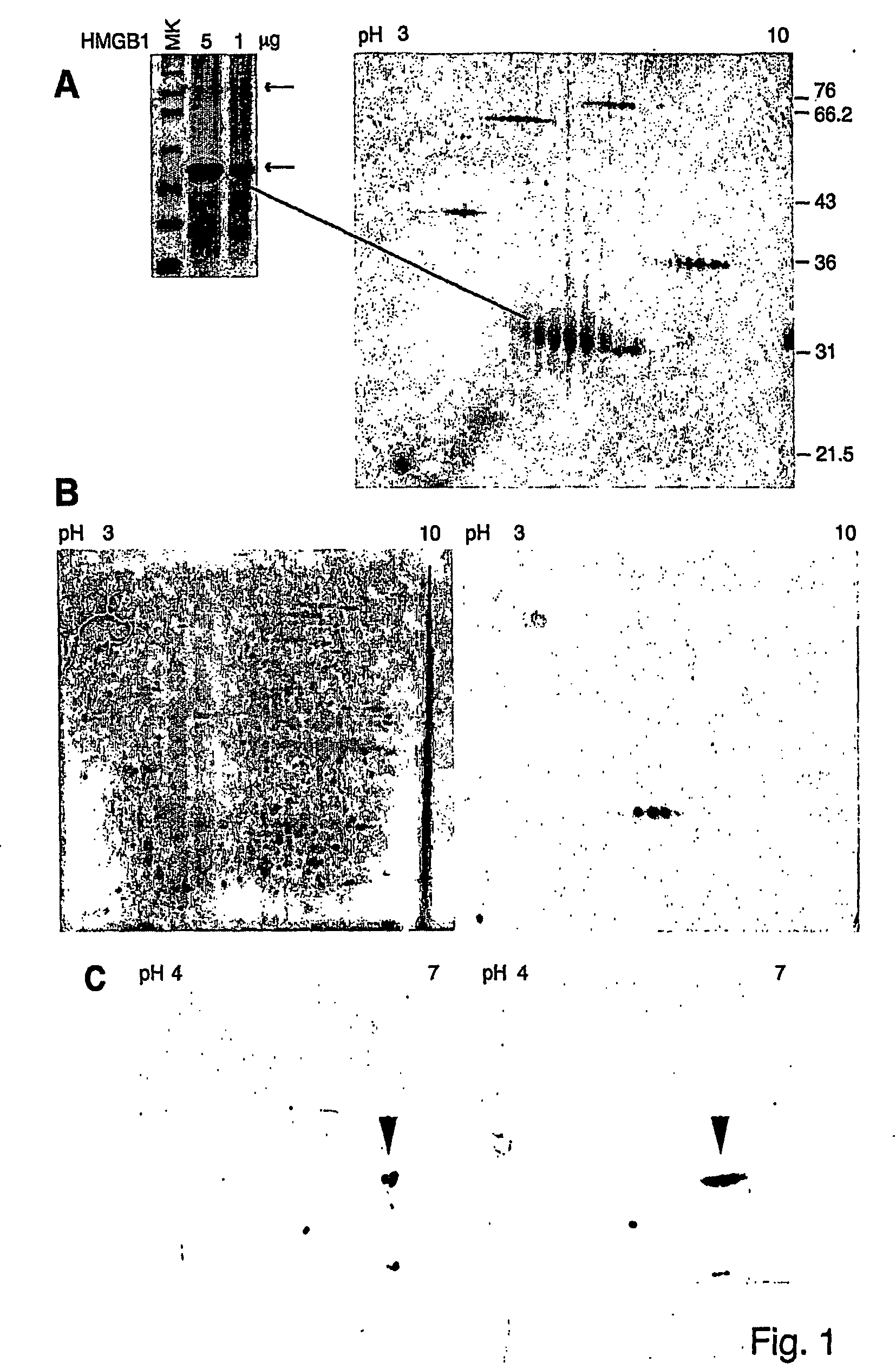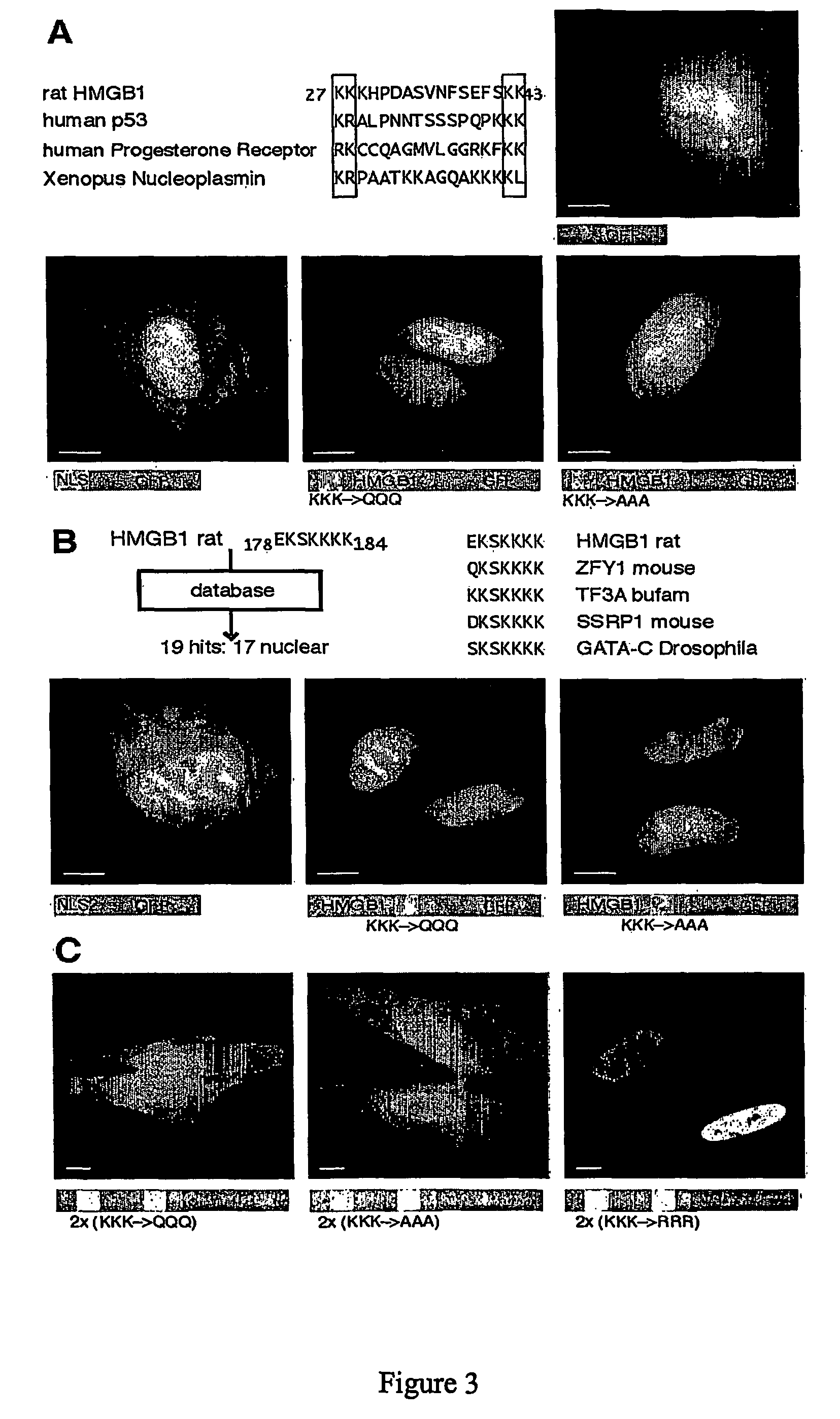Acetylated protein
a technology of hmgb1 and acetylated protein, which is applied in the direction of dna/rna fragmentation, peptide/protein ingredients, depsipeptides, etc., can solve the problems of unwanted inflammation and side effects
- Summary
- Abstract
- Description
- Claims
- Application Information
AI Technical Summary
Benefits of technology
Problems solved by technology
Method used
Image
Examples
example 1
Protein Expression and Purification
[0294] Expression and purification of bacterially produced full-length HMGB1 and fragments thereof were performed as described (Müller et al., 2001a). HMGB1 was purified from calf thymus according to the protocol kindly provided by J. Bernués (CSIC, Barcelona). Briefly, the organ is minced in Buffer 1 (0.14 M NaCl, 0.5 mM EDTA, 0.1 mM PMSF), after removing the fat and the connective tissue. The homogenate is subjected to three 5% PCA extractions; supernatants collected after centrifuging are pooled and clarified with TCA (18% final concentration). Fractionated precipitations with acetone-HCl (400:1 v / v) and acetone alone eliminate histone H1. The sediment, dissolved in borate buffer pH 9.0 is then passed once or twice (according to the purity of the sample) on a CM-Sephadex C25 column, and eluted with a NaCl gradient from 0.11 M to 0.2 M.
[0295] Throughout this specification, residues in HMGB1 have been numbered according to Allfrey and coworkers:...
example 3
2D Gel Electrophoresis
[0301] About 50 μg of purified HMGB1 or about 250 μg of total cellular protein were added to 350 μl of rehydration buffer (RB), containing 8 M urea, 2% CHAPS, 20 mM dithioerythritol (DTE), 0.8% IPG buffer (carrier ampholytes, pH 3-10 non-linear or pH 4-7 linear). Samples were applied on 18 cm polyacrylamide gel strips (pH range: 3-10 NL, or pH 4-7 L). Isoelectrophocusing (IEF) was performed in IPGphor (Pharmacia Biotech). IEF was stopped at 75000-90000 VoltHours. Second dimension runs were performed using a Protean II apparatus (Bio-Rad). After IEF, strips were soaked first in equilibration buffer (EB: 6 M urea, 3% SDS, 375 mM Tris pH 8.6, 30% glycerol, 2% DTE), then in EB containing 3% iodoacetamide (LAA) and traces of bromophenol blue (BBP). Strips were then applied onto 10%-12% polyacrylamide gels. Gels were run at 90 V for about 16 hours, and were then either silver stained or transferred onto nitrocellulose membranes (ECL, Amersham) in 25 mM Tris pH 7.5, ...
example 4
Mass Spectrometry
[0302] Isolated protein spots were excised from 2D gels stained with colloidal Coomassie, and reduced and alkylated as described (Shevchenko et al., 1996). We then performed sequential digestions using different sequence specific proteases and / or chemical cleavage. In particular, Trypsin, Asp-N, Glu-C digestions were performed in 50 mM NH4HCO3 buffer pH 8.0 at 37° C., with shaking. Time of digestion varied from 3 hours to overnight according to the efficiency of cleavage. Chemical cleavage with formic acid (Asp-C) was achieved by incubating spots overnight at 56° C. in 2% formic acid. Spots blotted on PVDF membranes were incubated in the presence of cyanogen bromide (CNBr) in 70% trifluoroacetic acid for 1 hour at RT in the dark. One μl of digestion products was loaded onto the MALDI target using the dried droplet technique and α-cyano-4-hydroxycinnamic acid (HCCA) or sinapinic acid as matrix.
[0303] MALDI-TOF mass measurements were performed on a Voyager-DE STR ti...
PUM
| Property | Measurement | Unit |
|---|---|---|
| Electric charge | aaaaa | aaaaa |
| Composition | aaaaa | aaaaa |
Abstract
Description
Claims
Application Information
 Login to View More
Login to View More - R&D
- Intellectual Property
- Life Sciences
- Materials
- Tech Scout
- Unparalleled Data Quality
- Higher Quality Content
- 60% Fewer Hallucinations
Browse by: Latest US Patents, China's latest patents, Technical Efficacy Thesaurus, Application Domain, Technology Topic, Popular Technical Reports.
© 2025 PatSnap. All rights reserved.Legal|Privacy policy|Modern Slavery Act Transparency Statement|Sitemap|About US| Contact US: help@patsnap.com



